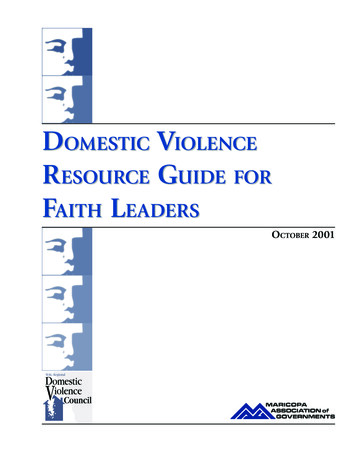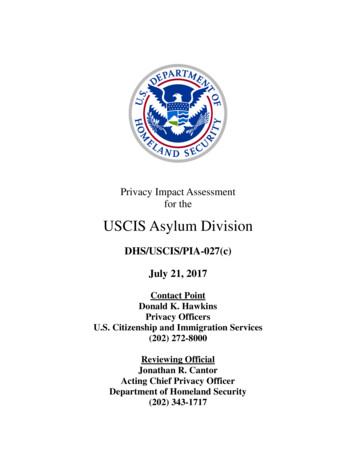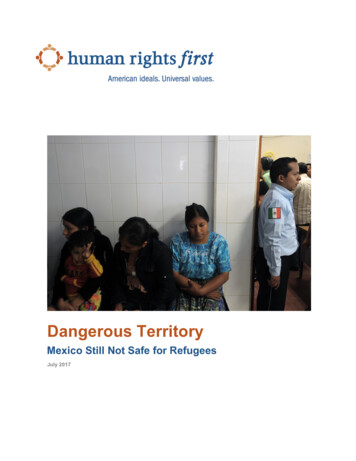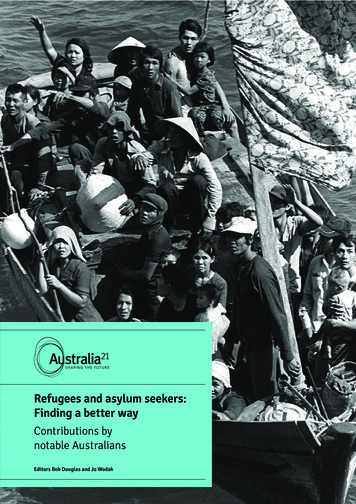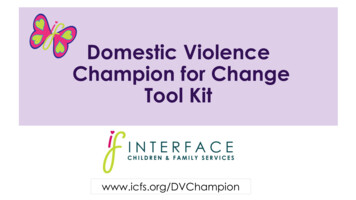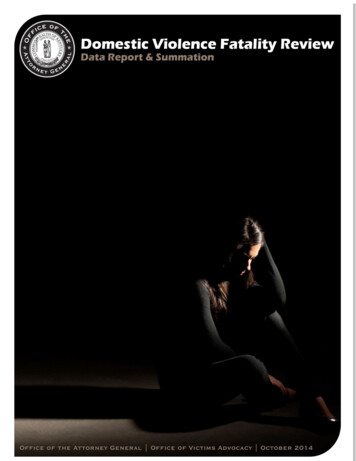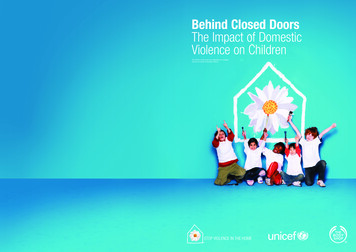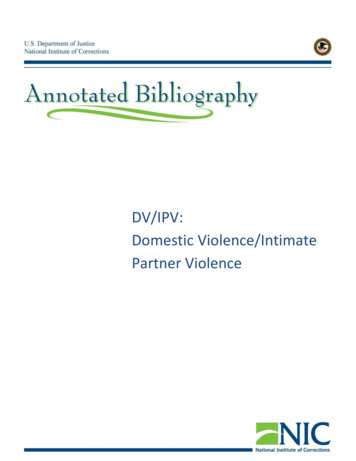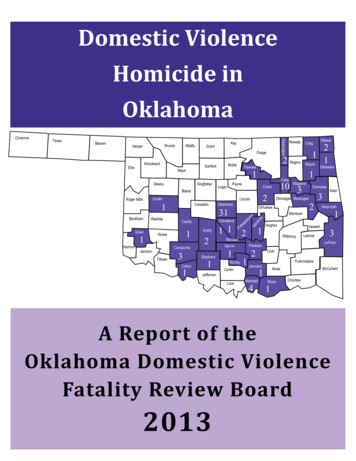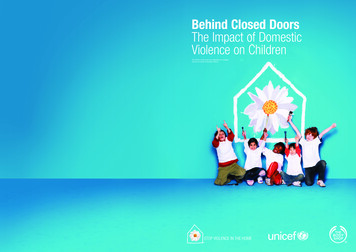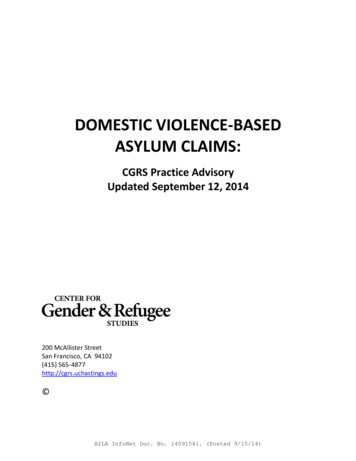
Transcription
DOMESTIC VIOLENCE-BASEDASYLUM CLAIMS:CGRS Practice AdvisoryUpdated September 12, 2014200 McAllister StreetSan Francisco, CA 94102(415) 565-4877http://cgrs.uchastings.edu AILA InfoNet Doc. No. 14091541. (Posted 9/15/14)
DOMESTIC VIOLENCE-BASED ASYLUM CLAIMS:CGRS Practice AdvisoryUpdated September 12, 2014IntroductionThank you for contacting CGRS about your asylum case involving domestic violence – a pervasive form ofgender-motivated violence affecting women and girls worldwide. At CGRS, we are playing a central rolein advising attorneys on gender asylum issues and tracking these cases to inform national policy work onthe issue. We encourage you to keep us up-to-date regarding the outcome of your case and anyinteresting developments along the way at http://cgrs.uchastings.edu/assistance.The focus of this advisory is on claims based on violence against women and girls at the hands ofintimate partners (husbands, domestic partners, boyfriends), though the advice provided herein mayalso be relevant to other gender-related claims. Part I of this advisory provides a brief overview of thelaw related to domestic violence and asylum in the United States. Part II provides guidance to attorneysrepresenting persons fleeing domestic violence, concentrating on developing claims based onmembership in a particular social group. Although the focus of the advisory is on asylum, it also brieflydiscusses applications for withholding of removal and Convention Against Torture (CAT) claims. Pleasealso note that CGRS has extensive country conditions packets, research memos, and expert declarationson relevant conditions in dozens of countries as well as sample briefs and pleadings, some of which areavailable on our website and others of which can be provided upon request.CGRS engages in technical assistance and country conditions research support free of charge. Weappreciate that many lawyers represent asylum seekers for little or no fee. However, we hope that youwill consider supporting our work in whatever way possible so that we are able to continue to providecritical assistance to you and your clients. Our website has more information about ways to get involvedhttp://cgrs.uchastings.edu/.General Asylum Overview & AdviceThe advice and information provided by CGRS assumes a familiarity with basic asylum law principles.Below is a selection of recommended sources for general information on asylum:AILA’s Asylum onsThe ILRC’s Asylum and Related Immigration Protectionshttp://www.ilrc.org/publicationsThe Ninth Circuit’s Immigration ion outline.phpThe NIJC’s Asylum Training -resourcesKurzban’s Immigration Law 81AILA InfoNet Doc. No. 14091541. (Posted 9/15/14)
I. Background: Domestic Violence Asylum Claims & Current State of the LawOn August 26, 2014, the Board of Immigration Appeals (BIA) issued the first ever precedent decisionrecognizing domestic violence as a basis for asylum and that women who flee such persecution mayestablish membership in a particular social group. This is a historic victory and repudiates the position ofsome immigration judges that these claims are categorically “unworthy” of relief. However, the BIA’sdecision does not touch on all elements of asylum that can be problematic in these cases, thus makingother related developments and guidance critical for successful presentation. This advisory providesbackground in developments in the law leading up to this BIA’s historic 2014 decision. Then, it providesan overview of the BIA’s 2014 ruling and provides advice for attorneys in developing claims forprotection.A. Matter of Kasinga: First Gender Asylum DecisionIn the United States, few refugee issues have been as controversial as that of gender asylum, that iswomen and girls fleeing gender-motivated harms.1 In 1996, the BIA broke new ground, issuing alandmark decision, Matter of Kasinga, 21 I. & N. Dec. 357 (BIA 1996), granting asylum to a Togolesewoman who fled her country to escape female genital cutting (FGC).2 In its decision, the BIA applied theholding of its seminal social group decision, Matter of Acosta, 19 I. & N. Dec. 211 (BIA 1985), to find thatMs. Kassindja (this is the correct spelling of her name) was the member of a particular social groupdefined by gender in combination with other immutable and fundamental characteristics.3The Kasinga decision implicitly overcame interpretive barriers that often stand in the way of relief ingender-based asylum claims. The BIA found female genital cutting to be persecution, notwithstandingthe fact that it is a widely condoned cultural practice in Togo. It recognized that particular social groupscould be defined in reference to gender and it did so in a case involving non-state actors – namely thefamily and community that sought to impose genital cutting. In addition, the BIA had no difficulty findinga nexus between the persecution and social group membership by taking the societal context into1For a more thorough review of the history of gender asylum in the United States and relevant internationalinstruments, see Karen Musalo, A Short History of Gender Asylum in the United States: Resistance and AmbivalenceMay Very Slowly Be Inching Towards Recognition of Women’s Claims, Refugee Survey Quarterly, Vol. 29, No. 2(2010).2Kasinga followed the issuance of gender guidelines in the United States. See Memorandum from Phyllis Coven,International and Naturalization Service (INS) Office of International Affairs, to All INS Asylum Officers and HQASMCoordinators, Considerations For Asylum Officers Adjudicating Asylum Claims From Women (May 26, 1995),reprinted in 72 Interpreter Releases 771 (1995). The Gender Considerations are generally positive in theirapproach and content. For example, the Considerations note the importance of analyzing gender claims within“the framework provided by existing international human rights instruments” and provide examples of genderedharms which could constitute persecution, including “sexual abuse, rape, infanticide, genital mutilation, forcedmarriage, slavery, domestic violence and forced abortion.” Id. at 2, 9. However, it should be noted that theseguidelines, which are directed only to Asylum Officers (not immigration judges or the BIA), are not binding and donot have the force of law.3The particular social group was defined as “[y]oung women of the Tchamba-Kunsuntu Tribe who have not hadFGM, as practiced by the tribe, and who oppose the practice.”2AILA InfoNet Doc. No. 14091541. (Posted 9/15/14)
consideration in line with the recommendations of the United Nations High Commissioner for Refugees(UNHCR).4B. Matter of R-A-: First Domestic Violence Asylum DecisionThree years later, in 1999, the BIA seemed to beat a hasty retreat from Matter of Kasinga, when itdenied asylum to Rody Alvarado, a Guatemalan woman who fled years of brutal domestic violence. Theimmigration judge (IJ) in Ms. Alvarado’s case initially granted asylum, ruling that she had suffered pastpersecution on account of her political opinion and membership in a particular social group defined as“Guatemalan women who have been involved intimately with Guatemalan male companions, whobelieve that women are to live under male domination.” The IJ also held that Ms. Alvarado hadestablished a well-founded fear of future persecution at the hands of her husband, who theGovernment of Guatemala was unwilling to control. The then Immigration and Naturalization Service(INS) appealed the IJ’s decision to the BIA, which – in a divided decision – reversed the grant of asylum inMatter of R-A-, 22 I. & N. Dec. 906 (BIA 1999).The BIA majority did not contest that the abuse Ms. Alvarado suffered was egregious or that the severeinjuries she sustained were more than sufficient to constitute persecution. Nor did the BIA dispute thatshe had established a failure of State protection. According to the majority, her claim failed because shedid not establish that the harm she suffered was on account of membership in a particular social groupor any other protected ground. With respect to defining the social group, the Board departed fromAcosta and ruled that being immutable/fundamental were only threshold requirements. An applicantalso had to establish that the proposed social group was “recognized and understood to be a societalfaction,” and Ms. Alvarado had failed to make that showing.5 The BIA further held that even if Ms.Alvarado’s proposed social group was cognizable, she had failed to show that her husband persecutedher because of her membership in it. In so ruling, the BIA distanced itself from its earlier Kasingadecision by largely rejecting the relevance of societal context of violence and discrimination againstwomen in determining nexus.4The BIA did not analyze the motivation of the individual or individuals who would inflict the FGC. Instead, itlooked to the evidence showing that female genital cutting is practiced “to overcome sexual characteristics ofyoung women” of the described social group, and on that basis concluded that it was “on account of” status in thatgroup.5This language regarding the recognition of a group as a societal faction was the forerunner to the BIA’s ruling thatnot all groups that share an immutable or fundamental characteristic are cognizable. In addition to the Acostafactors, the BIA has required that “social visibility” and “particularity” of the groups be established.3AILA InfoNet Doc. No. 14091541. (Posted 9/15/14)
C. Aftermath of Matter of R-A-: DHS Position on Domestic Violence-Based Asylum Cases in RA- and L-RThe BIA’s decision in Matter of R-A- provoked a firestorm of criticism, leading to a series of Executiveactions. In 2000, under the leadership of Attorney General (AG) Janet Reno, the Department of Justice(DOJ) proposed regulations to address cases such as Ms. Alvarado’s.6 Although the actual regulation isvery short, it is preceded by a lengthy preamble, which includes a substantial amount of guidancefavorable to gender claims based on domestic violence. Notably, the preamble states that the purposeof the regulation is to remove “certain barriers that the In re R-A- decision seems to pose” to domesticviolence claims, and recognizes that gender is an immutable characteristic and that marital status maybe considered immutable in appropriate circumstances. After the proposed regulation was issued, in2001, AG Reno vacated the BIA’s decision in Matter of R-A-, denying relief and remanding the case tothe BIA with instructions to stay the case until the proposed regulations were finalized.Then, in 2003, AG John Ashcroft took jurisdiction and ordered lawyers for the parties to brief the issuesin the case. In its 2004 brief, the Department of Homeland Security (DHS) reversed course from thegovernment’s previous position and argued that Ms. Alvarado had established statutory eligibility forasylum based on her membership in a particular social group.7 The brief reaffirmed Acosta’s immutable/fundamental test as the touchstone for defining social groups. It argued that marital status may beimmutable, where religious or moral convictions, or other factors make it so. DHS further took theposition that the size of the group should not be determinative and that groups need not be small to becognizable (though groups risk being overbroad if defined by traits that are not the characteristicstargeted by the persecutor). Moreover, the 2004 brief addressed nexus in a manner that incorporatescircumstantial evidence of the societal context in which the violence is perpetrated.In Ms. Alvarado’s case, DHS suggested that a cognizable social group in domestic violence claims underAcosta could be “married women in Guatemala who are unable to leave the relationship.” Though DHSrecommended a grant of asylum to Ms. Alvarado on the basis of her membership in a particular socialgroup defined by her gender, nationality and status in a domestic relationship, AG Ashcroft did not ruleon the case but sent it back to the BIA with the same instructions as his predecessor, for the BIA toreconsider the case once the proposed regulations were issued as final. To date, the proposedregulations have not been issued in final form.8In 2008, AG Michael Mukasey lifted the stay previously imposed on the BIA, as the regulations were stillpending, and remanded the case for reconsideration of the issues presented with respect to asylumclaims based on domestic violence. Because of the length of time the case had been pending, Ms.Alvarado and DHS made a joint request to send the case back to the IJ for the submission of additionalevidence and legal arguments. After the submission of these materials, DHS stipulated to a grant of6Asylum and Withholding Definitions, 65 Fed. Reg. 76588 (proposed Dec. 7, 2000) (hereafter ProposedRegulations).7DHS’s Position on Respondent’s Eligibility for Relief, Matter of R-A-, 23 I. & N. Dec. 694 (A.G. 2005) (A 73 753922), available at ter%20of%20R-A-%20DHS%20brief.pdf (lastvisited Aug. 12, 2014).8The Obama Administration indicated its intention to issue the proposed regulations in 2010, but this neverhappened. See The Regulatory Plan, 74 Fed. Reg. 64137, 64220-21 (Dec. 7, 2009).4AILA InfoNet Doc. No. 14091541. (Posted 9/15/14)
asylum, and finally, in December 2009, after enduring more than a decade of legal limbo, Ms. Alvaradowas granted asylum. Because the grant was by stipulation, there is no extensive IJ decision; the judge’sorder, which is less than a sentence long, simply refers to the agreement of the parties.9 Because theR-A- case had become the battleground on which the issue of domestic violence as a basis of asylum hadbeen fought for more than a decade, the victory had great symbolic significance. However, it has nobinding precedential value.10While R-A- was pending before the IJ, DHS filed a supplemental brief to the BIA in a similar case, knownas Matter of L-R-, involving the claim of a Mexican woman who fled to the United States after enduringmore than two decades of atrocious abuse at the hands of her common law husband.11 Initially, DHSfiled a brief to the BIA defending the IJ’s ruling that there was neither a cognizable gender-defined socialgroup nor a nexus to an enumerated ground. However, in 2009, under the new Obama Administration,DHS retreated from that position. The agency’s approach in its supplemental brief in L-R- builds on theposition it articulated in its R-A- brief five years prior and articulates the agency’s official positionregarding domestic violence claims. The significant difference between the 2004 and 2009 briefs is thatthe latter sets forth the agency’s position as to how the BIA’s new social group requirements of “socialvisibility” and “particularity,” imposed by the BIA in 2006 during the protracted battle in R-A-, can bemet in such cases.12 As discussed below, these new standards have been explained by the BIA in twindecisions issued in February 2014.Specific to Ms. L.R., DHS advanced two formulations of a social group that it argued could meet theimmutability, visibility, and particularity requirements, depending on the facts in the record: (1) Mexicanwomen in domestic relationships who are unable to leave; or (2) Mexican women who are viewed as9The IJ’s decision simply stated that: “Inasmuch as there is no binding authority on the legal issues raised in thiscase, I conclude that I can conscientiously accept what is essentially the agreement of the parties [to grantasylum].” Decision of the IJ, Dec. 10, 2009 (on file with CGRS).10After AG Mukasey’s 2008 order issued, the BIA remanded some domestic violence cases back to the immigrationcourt for attorneys to supplement the records in their cases. And, on at least one occasion, the BIA provided anapplicant with the opportunity to submit an application for asylum in light of the AG’s decision. See, e.g., In re:Ventura-Aguilar, A 98-400-001, 2009 Immig. Rptr. LEXIS 781 (BIA Dec. 2009) (remanding to IJ to provideopportunity for applicant to submit application for asylum and withholding of removal in light of vacatur of R-A-).See also, e.g., Morrison v. INS, 166 F. App’x 583 (2d Cir. 2006) (reversing BIA’s denial of applicant’s motion toreconsider for failure to consider issues related to domestic violence claim in light of vacatur of R-A-). On the otherhand, CGRS’s non-official tracking of cases has revealed that the BIA has also denied several motions to reopen topresent asylum claims based on domestic violence in light of Mukasey’s 2008 order and the DHS’s position taken inMatter of L-R-, discussed infra. This is not to say that attorneys should forego filing a motion to reopen where thecircumstances so require, but rather, to alert attorneys to one potential outcome. The argument for reopening isstronger now after the BIA’s long-awaited precedential decision (discussed in the following section), issued onAugust 26, 2014, recognizing domestic violence as a basis for asylum. See Matter of A-R-C-G-, 26 I. & N. Dec. 388(BIA 2014).11DHS’s Supplemental Brief, Matter of L-R- (BIA Apr. 13, 2009), available atter of LR DHS Brief 4 13 2009.pdf (last visited Aug. 12, 2014).12See Matter of C-A-, 23 I. & N. Dec. 951 (BIA 2006), aff’d Castillo-Arias v. Att’y Gen., 446 F.3d 1190 (11th Cir.2006). Social visibility requires that the members of the group be visible to the society at large, while particularityrequires that the group be clearly defined with concise boundaries.5AILA InfoNet Doc. No. 14091541. (Posted 9/15/14)
property by virtue of their position in a domestic relationship. DHS suggested that the case be remandedto the IJ for additional pertinent fact-finding. Without issuing a precedential opinion clarifying thegoverning doctrine, the BIA heeded DHS’s request. Upon review of Ms. L.R.’s supplemental evidentiaryand legal submissions, DHS – as it had done in the R-A- case – stipulated that Ms. L.R. was eligible forasylum and merited it in the exercise of discretion. In 2010, the IJ granted asylum in a summary order,which simply states that asylum is granted and includes a notation that it was a result of “stipulation ofthe parties.”13 Like the decision in R-A-, the decision holds no precedential value.D. Recent Developments: BIA Precedent Decision, Matter of A-R-C-G-, Recognizing DomesticViolence as a Basis for AsylumOn August 26, 2014, after a 15-year silence since its decision in R-A-, the BIA issued a precedentialdecision, Matter of A-R-C-G-, recognizing domestic violence as a basis for asylum.14 The applicant in thecase, Ms. C-G-, a mother of three, suffered what the decision deems “repugnant abuse” at the hands ofher husband, including beatings, rapes, an assault that broke her nose, and an attack with paint thinnerthat left her with burn scars. Her efforts to get police protection were in vain, as they refused tointerfere, and her husband threatened to kill her if she contacted them again. Her husband thwarted herrepeated efforts to leave and stay with relatives when he found her and threatened her if she did notreturn.The BIA found that women fleeing domestic violence can be members of a particular social group (inthat case, “married women in Guatemala who are unable to leave their relationship”). The BIA held thatthe social group defined by gender, nationality and marital status “comports with [its] recent precedents[Matter of M-E-V-G-, 26 I. & N. Dec. 227 (BIA 2014) and Matter of W-G-R-, 26 I. & N. Dec. 208 (BIA2014)] clarifying the meaning of the term ‘particular social group.’”15 In other words, based on the factsand evidence presented in the case, the gender defined social group meets the immutability, “socialdistinction” (formerly “social visibility”), and “particularity” requirements. (These decisions, M-E-V-Gand W-G-R-, and the BIA’s analysis of the requirements in A-R-C-G- are discussed in detail below.) TheBIA did not rule on the issue of nexus or inability/unwillingness of the government to protect Ms. C-G-,instructing the IJ to consider those issues on remand.Although the BIA affirmed the principle from M-E-V-G- and W-G-R- that cognizability of a social groupmust be determined on a case-by-case basis, the BIA’s analysis should help guide attorneys andapplicants in building the records in their cases to establish group membership for women fleeingdomestic violence from Guatemala and elsewhere. Importantly, the BIA’s clear recognition that womenfleeing domestic violence at the hands of their intimate partners are deserving of asylum protectionwhere their governments are unable or unwilling to protect them, sends a clear mandate to immigrationjudges that these cases must be carefully considered and cannot be rejected categorically as “unworthy”of relief. 1613Decision of the IJ, Aug. 4, 2010 (on file with CGRS).1426 I. & N. Dec. 388.15Id. at 392.16See Blaine Bookey, Domestic Violence as a Basis for Asylum: An Analysis of 206 Case Outcomes in the UnitedStates from 1994 to 2012, 24 Hastings Women's L.J. 107 (2013) (analyzing several domestic violence asylum cases6AILA InfoNet Doc. No. 14091541. (Posted 9/15/14)
CGRS will continue to engage with DHS and others in the Administration to ensure consistency inapplication of the BIA’s decision and of the government’s position in domestic violence cases acrossjurisdictions. We will also continue to advocate for finalization of asylum regulations to ensure thatwomen who have endured domestic violence and whose countries fail to protect them can clearlyestablish eligibility for asylum with sufficient guidance addressing all of the elements. To inform ourbroader policy work we encourage attorneys to contact CGRS if the asylum office refers a domesticviolence case to the immigration court for failure to establish social group membership or nexus to suchgroup membership or if a DHS trial attorney makes an argument to an IJ or the BIA that is inconsistentwith the BIA’s opinion in A-R-C-G- or with the agency’s position in L-R-.17CGRS offers attorneys the following advice to help attorneys craft successful claims, developed based onthe BIA’s decision in A-R-C-G- as well as our analysis of the outcomes of several hundred domesticviolence asylum cases for which CGRS has on-file oral or written decisions that have come to ourattention over the last two decades.and finding inconsistent and contradictory outcomes in cases while there was an absence of binding case law orregulations, including some judges who rejected domestic violence claims across the board).17Practitioners representing asylum seekers affirmatively should be aware that because the Asylum Office (AO) ispart of DHS, asylum officers are bound by the agency’s position. As a result, the AO should grant cases where theevidence supports both the applicant’s membership in the social group(s) articulated in the L-R- brief and theargument that persecution is linked to social group membership. Please note, however, that a claim could bereferred on the basis of relocation being reasonable, the one-year bar, or other grounds.7AILA InfoNet Doc. No. 14091541. (Posted 9/15/14)
II. CGRS AdviceWe note at the outset that this advisory provides only a brief footnote regarding the element ofpersecution necessary to establish eligibility for asylum because, in our experience, it is often notcontested due to the physical and sexual nature of abuse.18 Moreover, because this advisory focuses ondomestic violence claims that involve intimate partner violence, it does not address the specificconsiderations that arise in claims involving child abuse, or threats of forced marriage or sale intohuman trafficking by family members. CGRS has available specific advisories regarding children’s claimsand other gender-based asylum claims.Special Note on Forced Relationship CasesDomestic violence asylum claims should be considered to encompass those where a man forces awoman or girl into a relationship or perceives a woman or girl as “his” despite her resistance. Thistype of claim is frequently seen from countries such as Mexico and the Northern Triangle countries inCentral America with high rates of gang activity, where the dynamics in gang culture reflectheightened patriarchal attitudes of society at large. These claims – even where the relationship is notconsensual or established for a long period of time – should be analyzed through the domesticviolence lens so long as the hallmarks of domestic violence (e.g., physical violence, sexual abuse,threats, jealousy and isolation, force and lack of agency, intimidation, and stalking) are present.19The social group argued in forced relationship cases such as these may be formulated differently fromclaims where a woman is married or has children with her partner (see the subsequent section onframing social groups). But if a man believes that a woman or girl is “his” and he has the right tocontrol her, even after a woman has refused his advances, in his view (and that of society) arelationship has formed.20 What is more, his belief that she is “his” without any indication of intereston her part is itself a reflection of attitudes and norms regarding gender roles, that men/boys aresuperior to women/girls and thus they get to decide what will happen in a relationship, includingwhether it will result in sex, reproduction, marriage, and, in the end, separation (i.e. it’s not over untilhe says it is).18Alongside severe beatings, many domestic violence cases involve rape or other sexual harm, which have beenfound to constitute persecution. See, e.g., Silaya v. Mukasey, 524 F.3d 1066, 1070 (9th Cir. 2008); Balachova v.Mukasey, 547 F.3d 374, 386-87 (2d Cir. 2008). Psychological harm and serious threats of harm – hallmarks ofdomestic violence – can also rise to the level of persecution. See, e.g., Butt v. Keisler, 506 F.3d 86, 91 (1st Cir.2007); Ouk v. Gonzales, 464 F.3d 108, 111 (1st Cir. 2006). Attorneys should, of course, submit evidence regardingthe physical and psychological harm suffered by the applicant including, for example, the applicant’s owntestimony, testimony of witnesses, and medical records where available. CGRS also advises attorneys to seek anevaluation by a mental health professional to determine whether an applicant suffers from psychological disordersresulting from the abuse (see section on one-year bar below where this evidence might also be relevant).19See, e.g., KERRY HEALEY ET AL., U.S. DEP’T OF JUSTICE, BATTERER INTERVENTION: PROGRAM APPROACHES AND CRIMINAL JUSTICESTRATEGIES (1998) (discussing hallmarks of domestic violence).20Similarly, DHS has recognized in L-R- that a relationship can persist even after a woman has clearly stated herintention to end the relationship and/or separated from her abuser where the abuser refuses to recognize an endto the relationship, which exists on the abuser’s terms. The same analysis should be applied to cases where awoman is forced into a relationship from the beginning.8AILA InfoNet Doc. No. 14091541. (Posted 9/15/14)
A. Social Group Claims1. Analytical FrameworkCGRS advises attorneys to follow the analytical framework for social groups set forth in the BIA’sdecision A-R-C-G-. The social group articulated in that case – defined by gender, nationality, andrelationship status – closely tracks that set forth by DHS in its briefs in L-R- and R-A- and providesguidance on the evidence in a particular case that fulfills the requirements of “social distinction” and“particularity,” as most recently set forth in the BIA’s M-E-V-G- and W-G-R- decisions.21 In addition tothe A-R-C-G- and DHS’s briefs in R-A- and L-R-, the principles articulated in the preamble to the DOJ’sproposed asylum regulations of 2000, although never finalized, should also help guide attorneys workingon these cases as well as UNHCR’s excellent guidelines on social group and gender. These documentsare all available on our website and we highly recommend that attorneys study them closely.To follow is a brief outline of the analytical framework to be fleshed out more thoroughly infra: Defining theParticular SocialGroup Determining nexusor “on account of” Establishing thegovernment is“unable orunwilling toprotect” Acosta is the starting point for analysisGender and nationality are immutableMarriage or other status in a domestic relationship can be immutablewhere certain factors make it soA group is socially distinct where perceived as such within society orwhere treated distinctly within societyRelationship status can be sufficiently clear to satisfy particularityGroups need not be small to be cognizable, but may be overbroad ifdefined by traits not targeted by the persecutorPersecutor need only act in part because of the protected characteristicRegardless of initial motive of persecutor, nexus can be established ifapplicant is later persecuted on account of protected groundPersecutor need not harm more than one person in the groupCan be determined by direct evidence of the persecutor’s beliefs orcircumstantial evidence of the legal and social norms that permit abuse ofgroup membersTest is whether the government has taken steps that reduce the fear tobelow the well-founded fear thresholdGovernment’s inability or unwillingness can be shown by attempts toobtain protection and lack of government response; or by countryconditions that show government’s inability or unwillingness (individualneed have sought protection if futile or potentially dangerous)21The BIA also left open the possibility that gender alone could define the social group. See Matter of A-R-C-G-, 26I. & N. Dec. at 395. As mentioned infra, this could be an appropriate social group (or gender plus nationality) toconsider based on the facts of your case, or it may be appropriate to argue this
A. Matter of Kasinga: First Gender Asylum Decision . In the United States, few refugee issues have been as controversial as that of gender asylum, that is women and girls fleeing gender-motivated harms.1 In 1996, the BIA broke new ground, issuing a landmark decision, Matter of Kasinga, 21 I. & N. Dec. 357 (BIA 1996), granting asylum to a Togolese
